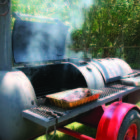Trending
Fireworks (n.): They’ve been around for 2,000 years, and have never ceased to amaze us
June, 2018

Loud, thrilling, beautiful… fireworks are often the icing on the cake at many holidays and celebrations. Indeed, Canada Day without some kind of pyrotechnic show, and the oohs and ahhs that follow, would seem rather amiss. In anticipation of this year’s fireworks at Mission Park, we look back at the long history of fireworks and how a tradition came to be.
Setting It Off
The world’s first fireworks appeared in China two millennia ago. That’s when scholars figured out that bamboo shoots heated over hot coals would eventually burst with a loud bang. Immediately, they saw the value for scaring away evil spirits. As a result, these proto-fireworks became popular at festive events such as weddings and New Years’ celebrations, where they were believed to not only keep evil at bay but invite good luck and happiness into people’s lives.
A few centuries later, things really heated up when Chinese alchemists stumbled upon the recipe for gunpowder. Consisting of an oxidizer, saltpeter, and two fuels—charcoal and sulfur— gunpowder was stuffed into those same bamboo shoots already being used as fireworks tubes for an even bigger punch. These new-and-improved fireworks continued to be used at festive celebrations, and people could purchase them from street vendors. The secret of gunpowder was eventually smuggled out of China via the Silk Road, making its way to the Middle East, where fireworks became known as “Chinese flowers.” Within a few decades, gunpowder appeared in Europe, kick-starting the proliferation of fireworks in the west.
Stars Over Italy
The Italians, in particular, ran with the idea of fireworks, creating elaborate light displays at religious ceremonies, coronations, and other celebrations. During the Renaissance they even opened up specialized fireworks schools. The master pyrotechnicians educated at these schools developed an assortment of firework varieties to light up the night, including sparklers, rockets, squibs, fire tubes, crackers, and—you guessed it—Roman candles. Later, in the 1830s, the Italians more or less invented modern fireworks when they developed the aerial shell. This is a tube within the firework that contains explosive balls or pellets called pyrotechnic stars. When launched into the air, a charge inside the shell detonates, opening it and raining out stars that then ignite and burst into a spectacular display of light. Moreover, by insulating the shell charge and by packing the stars in different ways, the shape (and ahh-factor) of the explosions can be manipulated.
And what about those colours? Well, around the same time that the Italians came up with the aerial shell, they also learned that adding different metals (in powder or salt form) to the stars would produce different colours. Strontium carbonate could be added for red explosions, barium chloride for green, copper chloride for blue, sodium nitrate for yellow, and so on. Even cooler, using potassium chlorate as an oxidizer would brighten these colours. So thanks for all that, Italy. As if pizza wasn’t enough.
Explosions in the Sky
Fireworks have come a long, long way from the days of tossing bamboo into fire and seeing what happens. Modern pyrotechnicians can send aerial fireworks higher than ever and have a dizzying array of effects at their disposal to wow audiences. In keeping with the original flower theme, many of these effects take floral forms. One of the best known is the peony, a nebulous sphere of coloured, ball-shaped stars that leave no trail as they burn. Willows, on the other hand, leave long trails that resemble the droop of a willow tree. Chrysanthemums are spherical, like peonies, but have visible trails, and can have layers of colour. Watch for these and other notable effects—brocades, fish, comets, and strobes—next time you catch a fireworks show. t8n
Playing with Fire
Up-to-date stats are hard to find, but a summary of fireworks-related injuries from 20 years ago by the Canadian Hospitals Injury Reporting and Prevention Program shows some trends. The majority of injuries are sustained by males (77.1%) mainly between the ages of 10 and 14 years old (42.3%). The most common injuries are burns (61.5%), though eye injuries (20.6%) are also significant. And as we would expect, injuries tend to peak around certain holidays—though surprisingly, Canada Day is third (8.6%), after Victoria Day (15.4%) and Halloween (20.0%).













